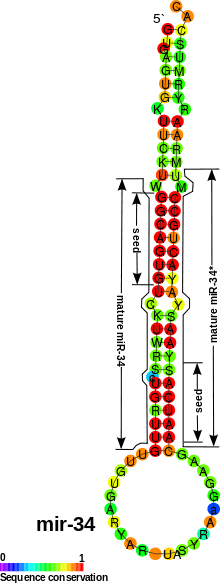mir-34 microRNA precursor family
| mir-34 microRNA precursor family | |
|---|---|
 | |
| Predicted secondary structure and sequence conservation of mir-34 | |
| Identifiers | |
| Symbol | mir-34 |
| Rfam | RF00456 |
| miRBase | MI0000268 |
| miRBase family | MIPF0000039 |
| Other data | |
| RNA type | Gene; miRNA |
| Domain(s) | Eukaryota |
| GO | 0035195 0035068 |
| SO | 0001244 |
The mir-34 microRNA precursor family are non-coding RNA molecules that, in mammals, give rise to three major mature miRNAs. The miR-34 family members were discovered computationally[1] and later verified experimentally.[2][3] The precursor miRNA stem-loop is processed in the cytoplasm of the cell, with the predominant miR-34 mature sequence excised from the 5' arm of the hairpin. The mature miR-34a is a part of the p53 tumor suppressor network; therefore, it is hypothesized that miR-34 dysregulation is involved in the development of some cancers.[4][5]
The miR-34 family
In mammals, three miR-34 precursors are produced from two transcriptional units.[6] The human miR-34a precursor is transcribed from chromosome 1. The miR-34b and miR-34c precursors are co-transcribed from a region on chromosome 11, apparently as part of a transcript known as BC021736.
Expression of MIR34A (gene) in mouse is observed in all tissues examined but is highest in brain. miR-34b and -c are relatively less abundant in most tissues, but are the predominant miR-34 species in lung.[6] The presence of miR-34 products has also been confirmed in embryonic stem cells. miR-34 has been shown to be maternally inherited in Drosophila and zebrafish and the loss of miR-34 resulted in defects in hindbrain development in zebrafish embryos. This was the first report of knockdown phenotype of miR-34 in any model organism although the phenotype was observed in only about 30% of zebrafish embryos.[7]
Targets of miR-34
Yamakuchi et al.. showed that miR-34a targets the silent information regulator 1 (SIRT1) gene:[8]
- "miR-34 inhibition of SIRT1 leads to an increase in acetylated p53 and expression of p21 and PUMA, transcriptional targets of p53 that regulate the cell cycle and apoptosis, respectively. Furthermore, miR-34 suppression of SIRT1 ultimately leads to apoptosis in WT human colon cancer cells but not in human colon cancer cells lacking p53. Finally, miR-34a itself is a transcriptional target of p53, suggesting a positive feedback loop between p53 and miR-34a. Thus, miR-34a functions as a tumor suppressor, in part, through a SIRT1-p53 pathway."[8]
Recently Quantitative proteomics - SILAC approach was used to identify miR-34a targets at genome level in HEK293T cells.[9]
Mir-34 inhibits human p53-mutant gastric cancer tumorspheres
p53-deficient human gastric cancer cells, restoration of functional miR-34 inhibits cell growth and induces chemosensitization and apoptosis, indicating that miR-34 may restore p53 function. Restoration of miR-34 inhibits tumorsphere formation and growth, which is reported to be correlated to the self-renewal of cancer stem cells. The mechanism of miR-34-mediated suppression of self-renewal appears to be related to the direct modulation of downstream targets Bcl-2, Notch, and HMGA2, indicating that miR-34 may be involved in gastric cancer stem cell self-renewal/differentiation decision-making.[10][11] miR-34c has also been associated to bone development and bone cancer.[12]
References
- ↑ Lim LP, Glasner ME, Yekta S, Burge CB, Bartel DP (Mar 2003). "Vertebrate microRNA genes". Science. 299 (5612): 1540. doi:10.1126/science.1080372. PMID 12624257.
- ↑ Dostie J, Mourelatos Z, Yang M, Sharma A, Dreyfuss G (Feb 2003). "Numerous microRNPs in neuronal cells containing novel microRNAs". RNA. 9 (2): 180–6. doi:10.1261/rna.2141503. PMC 1370383
 . PMID 12554860.
. PMID 12554860. - ↑ Houbaviy HB, Murray MF, Sharp PA (Aug 2003). "Embryonic stem cell-specific MicroRNAs". Developmental Cell. 5 (2): 351–8. doi:10.1016/S1534-5807(03)00227-2. PMID 12919684.
- ↑ Mraz M, Malinova K, Kotaskova J, Pavlova S, Tichy B, Malcikova J, Stano Kozubik K, Smardova J, Brychtova Y, Doubek M, Trbusek M, Mayer J, Pospisilova S (Jun 2009). "miR-34a, miR-29c and miR-17-5p are downregulated in CLL patients with TP53 abnormalities". Leukemia. 23 (6): 1159–63. doi:10.1038/leu.2008.377. PMID 19158830.
- ↑ He L, He X, Lim LP, de Stanchina E, Xuan Z, Liang Y, Xue W, Zender L, Magnus J, Ridzon D, Jackson AL, Linsley PS, Chen C, Lowe SW, Cleary MA, Hannon GJ (Jun 2007). "A microRNA component of the p53 tumour suppressor network". Nature. 447 (7148): 1130–4. doi:10.1038/nature05939. PMID 17554337.
- 1 2 Hermeking H (Feb 2010). "The miR-34 family in cancer and apoptosis". Cell Death and Differentiation. 17 (2): 193–9. doi:10.1038/cdd.2009.56. PMID 19461653.
- ↑ Soni K, Choudhary A, Patowary A, Singh AR, Bhatia S, Sivasubbu S, Chandrasekaran S, Pillai B (Apr 2013). "miR-34 is maternally inherited in Drosophila melanogaster and Danio rerio". Nucleic Acids Research. 41 (8): 4470–80. doi:10.1093/nar/gkt139. PMC 3632126
 . PMID 23470996.
. PMID 23470996. - 1 2 Yamakuchi M, Ferlito M, Lowenstein CJ (Sep 2008). "miR-34a repression of SIRT1 regulates apoptosis". Proceedings of the National Academy of Sciences of the United States of America. 105 (36): 13421–6. doi:10.1073/pnas.0801613105. PMC 2533205
 . PMID 18755897.
. PMID 18755897. - ↑ Bargaje R, Gupta S, Sarkeshik A, Park R, Xu T, Sarkar M, Halimani M, Roy SS, Yates J, Pillai B (2012). "Identification of novel targets for miR-29a using miRNA proteomics". PLOS ONE. 7 (8): e43243. doi:10.1371/journal.pone.0043243. PMC 3428309
 . PMID 22952654.
. PMID 22952654. - ↑ Ji Q, Hao X, Meng Y, Zhang M, Desano J, Fan D, et al. (2008). "Restoration of tumor suppressor miR-34 inhibits human p53-mutant gastric cancer tumorspheres". BMC Cancer. 8: 266. doi:10.1186/1471-2407-8-266.
- ↑ Mir-34 and p53 pathway
- ↑ Bae Y, Yang T, Zeng HC, Campeau PM, Chen Y, Bertin T, Dawson BC, Munivez E, Tao J, Lee BH (Jul 2012). "miRNA-34c regulates Notch signaling during bone development". Human Molecular Genetics. 21 (13): 2991–3000. doi:10.1093/hmg/dds129. PMC 3373245
 . PMID 22498974.
. PMID 22498974.
External links
- Page for mir-34 microRNA precursor family at Rfam
- miRBase entry for mouse miR-34a (mmu-miR-34a)
- miRBase entry for human miR-34a (hsa-miR-34a)